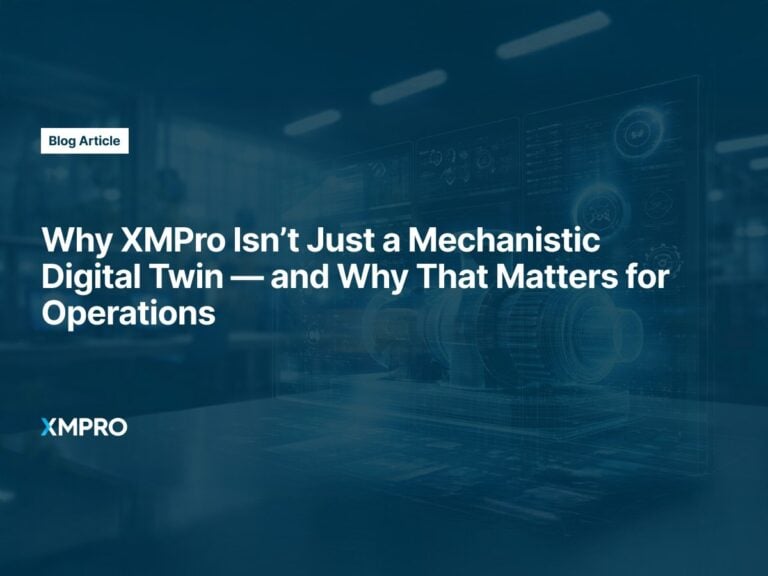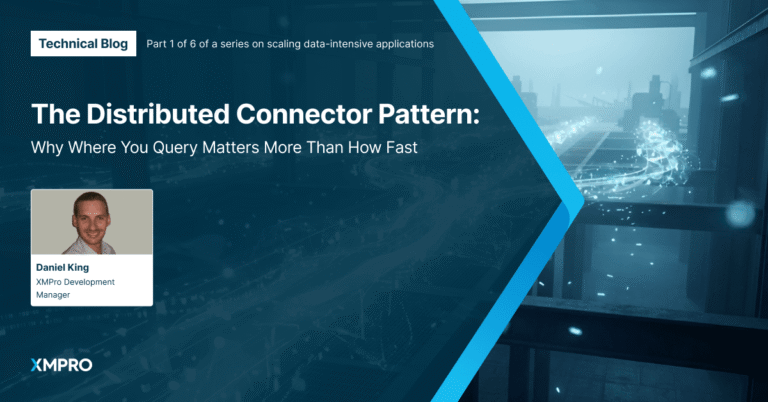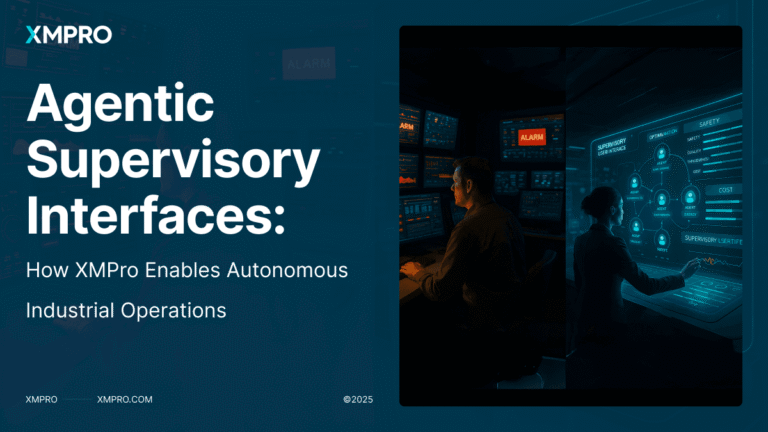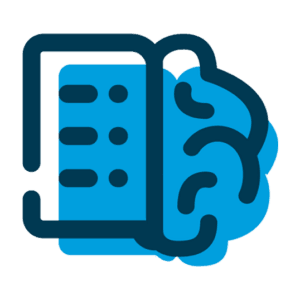XMPro is an industrial Decision Intelligence and Agentic AI platform that helps asset-intensive enterprises solve complex operational problems at scale — quickly and safely.
Its core product, the Intelligent Business Operations Suite (iBOS), is the only AI-powered, composable platform that lets engineering and IT teams rapidly design and deploy solutions that monitor assets and processes, detect risks or opportunities in real time, recommend or automate actions, and scale those solutions across plants and geographies.
At the heart of iBOS is XMPro’s Multi-Agent Generative Systems MAGS — an enterprise-grade Agentic AI architecture built for bounded autonomy, explainability, reliability, and safety. MAGS turns raw industrial data into trusted, actionable intelligence that executives can use to move from dashboards to autonomous, value-driven operations.
Unlike monolithic digital twin tools or custom AI projects, XMPro is composable and deployment-agnostic — it connects to existing ERP, MES, SCADA, historians, and cloud platforms without rip-and-replace, and runs in the cloud, on-premises, at the edge, or in air-gapped networks.
This approach lets enterprises start small, scale fast, retain governance, and realize >1000% ROI through reduced downtime, optimized maintenance, and accelerated AI adoption.
XMPro helps industrial enterprises remove the biggest barriers to running more, producing more, and doing it safely and profitably.
Typical challenges we solve include the following:
-
Siloed OT/IT data → unifies SCADA, historians, IoT, ERP, MES, and cloud sources into one actionable operational model.
-
Unplanned downtime & high maintenance cost → predictive and prescriptive maintenance using Multi-Agent Generative Systems MAGS to cut failures and keep assets running longer.
-
Dashboard overload & slow decisions → transforms raw data into explainable, real-time recommendations or automated actions, so teams act fast and confidently.
-
Inconsistent product quality → real-time monitoring and AI agents that predict deviations and maintain quality standards.
-
Loss of expert knowledge → captures engineering know-how and embeds it into AI-driven workflows for repeatable best practice.
-
Scaling AI beyond pilots → composable architecture replicates proven use cases across plants and regions without rebuilding from scratch.
-
Safety & compliance risk → trusted, governed automation and early warnings for regulated and safety-critical environments.
-
Path to autonomy → supports the full journey from human-assisted decisions to trusted autonomous operations.
The result: higher output, fewer stoppages, better quality, safer operations — and ROI that scales from single assets to enterprise-wide impact.
Decision Intelligence (DI) is the discipline of turning raw industrial data into better business decisions — faster, safer, and at scale.
It combines data integration, advanced analytics, AI, and human expertise to help organizations move beyond dashboards to decisions that can be explained, trusted, and acted on automatically.
XMPro was built specifically to bring Decision Intelligence to asset-intensive industries. The Intelligent Business Operations Suite (iBOS):
-
Connects and contextualizes data from SCADA, historians, IoT, ERP, MES, and cloud platforms.
-
Analyzes and predicts using analytics, machine learning, and Multi-Agent Generative Systems MAGS.
-
Presents explainable recommendations or automates actions, keeping humans in control where needed.
-
Scales and governs these decision flows across plants and geographies while preserving IT/OT security and compliance.
This lets enterprises move from raw data → insight → decision → action → autonomy, delivering measurable ROI while maintaining trust, transparency, and safety in every AI-driven step.
Agentic AI refers to AI systems that can reason, plan, collaborate, and act toward goals — moving beyond single-task machine learning models or chatbots.
XMPro’s implementation, called Multi-Agent Generative Systems MAGS, is designed specifically for mission-critical industrial environments.
Traditional AI “agents” are often prompt-driven wrappers around large language models (LLMs). They can automate tasks but struggle with trust, explainability, safety, and integration in complex operations.
XMPro MAGS are fundamentally different:
-
Bounded autonomy – agents act within clear objectives and safety constraints defined by the business.
-
Explainable reasoning – every recommendation or action is traceable and auditable, supporting compliance and operator trust.
-
Team-based collaboration – multiple specialized agents work together (e.g., anomaly detection, predictive maintenance, scheduling) to solve complex problems.
-
Enterprise integration – built to connect with SCADA, MES, ERP, historians, and cloud platforms, not just APIs.
-
Governed lifecycle – versioning, monitoring, and control keep AI behavior stable and manageable over time.
This makes XMPro MAGS a production-ready foundation for industrial autonomy — safe, explainable, and scalable where traditional agent frameworks fall short.
No. XMPro is designed to work with the systems you already have — not replace them.
The Intelligent Business Operations Suite (iBOS) is composable and integration-friendly, connecting to ERP, MES, SCADA, historians, IoT platforms, and cloud services through open standards and proven industrial protocols.
Instead of ripping out core control or enterprise systems, XMPro adds a Decision Intelligence layer on top. This layer unifies data, applies advanced analytics and Multi-Agent Generative Systems MAGS, and delivers trusted recommendations or automated actions back into your existing workflows.
XMPro is also deployment-agnostic: it can run in the cloud, on-premises, at the edge, or in air-gapped networks, meeting security and compliance requirements without forcing infrastructure change.
Bottom line: XMPro lets you modernize and scale AI-driven decision making without disrupting your operational backbone.
XMPro accelerates digital transformation and de-risks AI adoption by providing a trusted intelligence layer that connects industrial data to real business outcomes — without forcing a rip-and-replace of existing systems.
-
Unify data & context – Connects to SCADA, historians, IoT sensors, ERP, MES, and cloud platforms, turning siloed signals into a single, actionable operational model.
-
Progressive Decision Intelligence – Guides organizations through the Decision Intelligence Continuum: from monitoring, to AI-assisted decision support, to autonomous agentic operations when ready.
-
Enterprise-grade Agentic AI MAGS – Purpose-built agents detect anomalies, predict failures, recommend actions, and automate workflows while staying explainable, reliable, and safe.
-
Composable, integration-friendly architecture – Works with existing infrastructure and supports cloud, on-premises, edge, and air-gapped deployments to meet security and compliance needs.
-
Fast ROI & scale – Start with high-impact pilots, prove value quickly, and scale globally without rebuilding use cases.
The result is a controlled, ROI-driven transformation — not just new dashboards, but measurable gains in uptime, quality, safety, and efficiency on the path to intelligent, autonomous operations.
XMPro was designed for mission-critical industries where AI must be safe, auditable, and under business control.
Its Multi-Agent Generative Systems (MAGS) architecture builds trust into every stage of decision automation:
-
Bounded autonomy – every agent operates within clearly defined objectives, guardrails, and safety constraints set by the business.
-
Explainable reasoning – actions and recommendations include traceable context and decision paths, so engineers and managers can see why an outcome was chosen.
-
Governed lifecycle – agents are versioned, monitored, and auditable, allowing IT and operations teams to control updates and rollbacks.
-
Consensus & validation – multiple agents can cross-check and validate each other’s outputs before action is taken.
-
Industrial-grade deployment – works in cloud, on-premises, edge, or air-gapped environments, meeting strict security and compliance needs.
This approach lets enterprises move toward autonomous operations with confidence — maintaining transparency, explainability, reliability, and safety while benefiting from advanced AI.
XMPro supports the entire lifecycle of industrial operations by providing a comprehensive suite of tools that facilitate each stage, from data acquisition to action. Here’s how XMPro addresses each phase:
- Data Acquisition and Integration: XMPro seamlessly integrates with various data sources, including SCADA systems, PLCs, ERPs, and IoT sensors, to collect real-time data. This ensures that all relevant data is captured and available for analysis.
- Data Contextualization: Once data is acquired, XMPro contextualizes it by adding meaningful information and relationships. This process transforms raw data into actionable insights, making it easier for decision-makers to understand and use.
- Real-Time Monitoring: XMPro provides real-time monitoring tools that enable continuous oversight of industrial processes. This helps in identifying anomalies, tracking performance, and ensuring that operations are running smoothly.
- Advanced Analytics: XMPro uses advanced analytics, including AI and machine learning, to analyze data and provide predictive insights. This helps in anticipating issues before they occur and optimizing processes for better efficiency.
- Event and Incident Management: With XMPro's Event Intelligence, organizations can manage events and incidents in real-time. This component ensures that critical events are detected, analyzed, and addressed promptly, minimizing disruptions.
- Decision Support: XMPro’s Recommendation Manager leverages AI to provide actionable recommendations based on real-time data analysis. This supports informed decision-making and helps in implementing the best course of action.
- Process Optimization: Through continuous monitoring and analytics, XMPro identifies opportunities for process optimization. This leads to improved efficiency, reduced costs, and enhanced productivity.
- Performance Management: XMPro’s dashboard and visualization tools allow users to monitor key performance indicators (KPIs) and other metrics. This helps in tracking performance and making data-driven improvements.
- Digital Twin Technology: XMPro’s Digital Twin Builder enables the creation of digital twins, providing a virtual representation of physical assets, processes, or systems. Digital twins offer valuable insights for predictive maintenance, performance optimization, and scenario planning.
- Scalability and Flexibility: XMPro’s scalable platform supports the growing needs of industrial operations. Whether starting with basic condition monitoring or advancing to sophisticated Multi-Agent Generative Systems MAGS, XMPro adapts to the organization's evolving requirements.
By supporting each phase of the industrial operations lifecycle, XMPro ensures that organizations can achieve a seamless and efficient digital transformation, driving continuous improvement and operational excellence.
XMPro’s AI capabilities are uniquely positioned to address the complex needs of industrial operations through several innovative features and approaches:
- Multi-Agent Generative Systems MAGS: XMPro leverages Multi-Agent Generative Systems, where multiple AI agents collaborate to optimize and manage industrial processes. Each agent specializes in specific tasks, such as predictive maintenance, performance optimization, and root cause analysis, enhancing overall system efficiency without a central supervising agent. This decentralized approach ensures flexibility and scalability in managing complex industrial environments, allowing agents to dynamically interact and adapt to real-time data.
- Advanced Data Integration: XMPro’s AI seamlessly integrates with real-time data from various sources, including SCADA systems, PLCs, ERPs, IoT sensors, and more. This integration ensures that AI models are continuously updated with the most current and relevant data, providing accurate and timely insights. XMPro’s DataStream connector framework enables drag-and-drop integrations across IT, OT, and engineering systems, ensuring seamless data flow and contextualization.
- Predictive and Prescriptive Analytics: XMPro goes beyond predictive analytics by incorporating prescriptive analytics, which not only forecasts potential issues but also recommends specific actions to address them. This proactive approach helps organizations anticipate problems and implement effective solutions, leading to improved operational efficiency and reduced downtime.
- Scalable and Flexible Framework: XMPro’s AI capabilities are built on a scalable and flexible framework that allows organizations to start small and expand as needed. Whether beginning with a single reliability agent or deploying a full suite of MAGS, XMPro can grow with the organization’s needs, ensuring that AI solutions can handle increasing data volumes and complexity.
- Customized AI Models: XMPro allows for the customization of AI models to meet specific industry needs and business processes. This ensures that the AI solutions are directly aligned with the unique challenges and goals of each organization, providing targeted and effective insights. XMPro’s visual, drag-and-drop interfaces make it easy to create and modify data flows, ensuring that AI models are tailored to specific operational contexts.
- Real-Time Decision-Making: XMPro’s AI agents are designed to operate in real-time, continuously monitoring and analyzing data to provide immediate insights and recommendations. This real-time capability is crucial for industries where timely decisions can significantly impact operational efficiency and safety. XMPro’s AI agents can autonomously act on insights or provide recommendations to human operators, ensuring quick and informed decision-making.
- Data Pipelines for Enhanced Decision-Making: XMPro employs a data pipeline approach, integrating diverse data sources and tools to contextualize decision data. This method supports complex reasoning processes, allowing AI agents to observe, reflect, learn, plan, act, and collaborate within a governance framework, ensuring data-driven and empirically grounded decisions. The visual, explainable approach of XMPro’s data pipelines simplifies the monitoring and debugging processes.
- Explainable AI: XMPro’s AI solutions provide a visual and explainable approach to their processes and logic. This transparency makes it easier to understand, troubleshoot, and fine-tune AI models, ensuring that users can trust and effectively utilize the insights generated. XMPro’s visual tools allow users to see how data is processed and decisions are made, fostering trust and facilitating continuous improvement.
- Proven Track Record: XMPro’s AI capabilities have been successfully implemented in numerous real-world scenarios, processing millions of monitoring events per day across complex industrial assets. These proven solutions have demonstrated significant improvements in operational reliability, cost efficiency, and decision-making. Case studies and success stories highlight the tangible benefits achieved by organizations using XMPro’s AI solutions.
- Focus on Industrial Applications: XMPro’s AI is specifically designed for industrial applications, addressing the unique needs and challenges of sectors such as manufacturing, mining, oil & gas, power utilities, and more. This industry-specific focus ensures that AI solutions are practical, impactful, and aligned with the strategic objectives of industrial organizations.
XMPro’s MAGS utilize a structured approach involving observation, reflection, planning, and action. Agents continuously share updates and collaborate to optimize performance while reducing costs and adhering to constraints. The extensible DataStream connector framework supports seamless integrations across IT, OT, and engineering systems, enabling flexible deployment of AI-driven solutions. By employing large language models (LLMs) for complex decision-making, XMPro’s AI agents can observe, reflect, plan, and act in a manner similar to human experts, ensuring that decisions are both data-driven and contextually relevant.
These features make XMPro’s AI capabilities stand out, providing organizations with powerful tools to drive digital transformation, optimize operations, and achieve their business objectives.
XMPro differentiates itself from other vendors by offering a unique combination of advanced AI capabilities, real-time data integration, and a highly scalable and composable platform. Unlike others, XMPro empowers enterprises to rapidly deploy scalable solutions, regardless of where they are on their digital transformation journey.
This means that organizations can swiftly advance their capabilities from rule-based and conditional logic monitoring workflows to cutting-edge Multi-Agent Generative Systems MAGS. Our focus on enabling intelligent business operations through seamless data orchestration and actionable insights sets us apart. Additionally, XMPro provides extensive support and customization options to ensure our solutions meet the specific needs of each client, driving efficiency, innovation, and growth.
Yes, XMPro can be seamlessly integrated with existing IT infrastructure, ensuring a smooth transition and enhanced operational efficiency. Here’s how XMPro achieves this:
- Extensive Integration Capabilities: XMPro supports a wide range of integration capabilities, allowing it to connect with various systems, including SCADA systems, PLCs, ERPs, IoT sensors, CRMs, and more. This ensures that all relevant data sources are unified within XMPro, providing a comprehensive view of operations.
- DataStream Connector Framework: XMPro’s DataStream connector framework provides a flexible and extensible platform for integrating different data sources. The drag-and-drop interface allows users to easily create and manage data streams, facilitating the integration process without the need for extensive coding or technical expertise.
- Real-Time Data Integration: XMPro enables real-time data integration, ensuring that data from various sources is continuously updated and available for analysis. This real-time capability is crucial for making timely and informed decisions, enhancing operational efficiency.
- Compatibility with Existing Systems: XMPro is designed to be compatible with existing IT systems and infrastructure. Whether your organization uses on-premise, cloud, or hybrid solutions, XMPro can be deployed and integrated to fit seamlessly into your current setup. This ensures minimal disruption to ongoing operations during the integration process.
- APIs and Custom Connectors: XMPro offers robust APIs and the ability to create custom connectors, enabling tailored integrations to meet specific business requirements. This flexibility ensures that even unique or proprietary systems can be connected to XMPro, ensuring comprehensive data integration.
- Support for Industry Standards: XMPro adheres to industry standards and protocols, ensuring compatibility with a wide range of industrial systems and technologies. This adherence facilitates smooth integration and interoperability with existing IT infrastructure.
- Scalable and Modular Architecture: XMPro’s scalable and modular architecture allows for incremental integration, enabling organizations to start with specific components and expand as needed. This modularity ensures that XMPro can grow with your organization’s needs, providing a future-proof solution.
- Security and Compliance: XMPro ensures that all integrations are secure and comply with relevant industry regulations and standards. Data encryption, user authentication, and access controls are implemented to protect sensitive information and maintain compliance.
- Proven Integration Success: XMPro has a proven track record of successful integrations with various IT infrastructures across different industries. Case studies and customer success stories highlight the seamless integration process and the significant benefits achieved by organizations using XMPro.
- Comprehensive Support and Services: XMPro provides extensive support and professional services to assist with the integration process. This includes training, documentation, and technical assistance to ensure a smooth and successful integration.
By leveraging these capabilities, XMPro ensures that it can be effectively integrated with your existing IT infrastructure, providing a unified platform for enhanced data management, real-time decision-making, and optimized operations.
Industrial enterprises using XMPro report rapid, measurable returns — often exceeding 1,000% ROI — by moving from siloed data and manual decision-making to trusted, AI-driven operations.
Examples include the following:
-
Global oil & gas supermajor – built and deployed an intelligent well maintenance solution in 3 months, achieving >$8 million in value in the first six months and >$16 million annual savings.
-
World’s largest potash mining company – reduced conveyor downtime by 30% across 50+ miles of underground conveyors in 30 days, driving $10 million in annual savings and 9,000 tons of extra throughput per month.
-
Major North American miner – scaled from one pilot to 6 sites and 1,000+ assets, independently composing 35+ operational, tactical, and strategic solutions in-house.
-
Global mining OEM – used XMPro’s predictive maintenance agents to trigger early haul-truck failure alerts weeks before breakdown, avoiding costly unplanned downtime.
Across industries, XMPro helps companies reduce downtime, cut maintenance costs, improve product quality, and scale AI safely, delivering multi-million-dollar savings and faster time to value.




























































